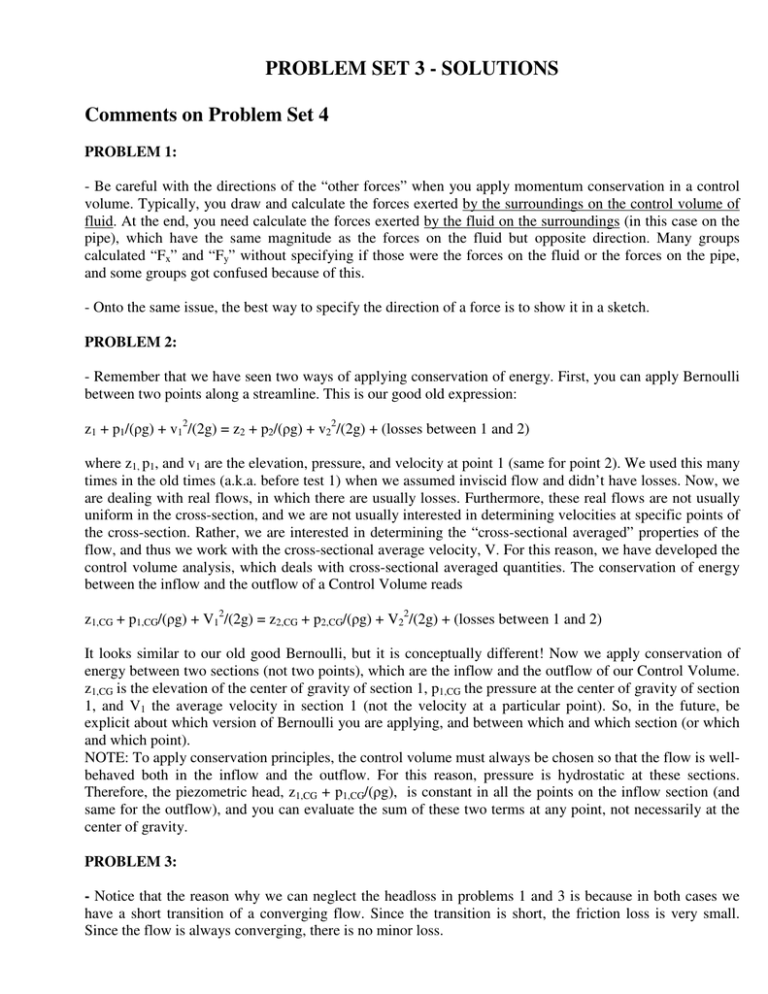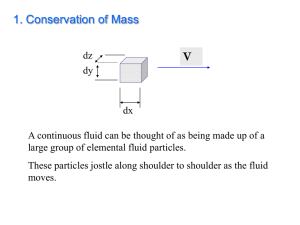PROBLEM SET 3 - SOLUTIONS Comments on Problem Set 4
advertisement

PROBLEM SET 3 - SOLUTIONS Comments on Problem Set 4 PROBLEM 1: - Be careful with the directions of the “other forces” when you apply momentum conservation in a control volume. Typically, you draw and calculate the forces exerted by the surroundings on the control volume of fluid. At the end, you need calculate the forces exerted by the fluid on the surroundings (in this case on the pipe), which have the same magnitude as the forces on the fluid but opposite direction. Many groups calculated “Fx” and “Fy” without specifying if those were the forces on the fluid or the forces on the pipe, and some groups got confused because of this. - Onto the same issue, the best way to specify the direction of a force is to show it in a sketch. PROBLEM 2: - Remember that we have seen two ways of applying conservation of energy. First, you can apply Bernoulli between two points along a streamline. This is our good old expression: z1 + p1/(ρg) + v12/(2g) = z2 + p2/(ρg) + v22/(2g) + (losses between 1 and 2) where z1, p1, and v1 are the elevation, pressure, and velocity at point 1 (same for point 2). We used this many times in the old times (a.k.a. before test 1) when we assumed inviscid flow and didn’t have losses. Now, we are dealing with real flows, in which there are usually losses. Furthermore, these real flows are not usually uniform in the cross-section, and we are not usually interested in determining velocities at specific points of the cross-section. Rather, we are interested in determining the “cross-sectional averaged” properties of the flow, and thus we work with the cross-sectional average velocity, V. For this reason, we have developed the control volume analysis, which deals with cross-sectional averaged quantities. The conservation of energy between the inflow and the outflow of a Control Volume reads z1,CG + p1,CG/(ρg) + V12/(2g) = z2,CG + p2,CG/(ρg) + V22/(2g) + (losses between 1 and 2) It looks similar to our old good Bernoulli, but it is conceptually different! Now we apply conservation of energy between two sections (not two points), which are the inflow and the outflow of our Control Volume. z1,CG is the elevation of the center of gravity of section 1, p1,CG the pressure at the center of gravity of section 1, and V1 the average velocity in section 1 (not the velocity at a particular point). So, in the future, be explicit about which version of Bernoulli you are applying, and between which and which section (or which and which point). NOTE: To apply conservation principles, the control volume must always be chosen so that the flow is wellbehaved both in the inflow and the outflow. For this reason, pressure is hydrostatic at these sections. Therefore, the piezometric head, z1,CG + p1,CG/(ρg), is constant in all the points on the inflow section (and same for the outflow), and you can evaluate the sum of these two terms at any point, not necessarily at the center of gravity. PROBLEM 3: - Notice that the reason why we can neglect the headloss in problems 1 and 3 is because in both cases we have a short transition of a converging flow. Since the transition is short, the friction loss is very small. Since the flow is always converging, there is no minor loss. Problem #4: A few groups didn't have the formula for head loss quite right – we must also take into account the elevation difference from one side of the hydraulic jump to the other. The formula can easily be derived from the equation: H_1 = H_2 + HL_(1-->2). See solutions for details. A handful of groups also answered the last part incorrectly. Conceptually, if we lose energy going from 1 --> 2, we'd have to gain energy if we went from 2 --> 1 (by conservation of energy). This would yield a negative head loss and negative energy dissipation (which implies a head gain and energy gain). This situation is physically impossible, so the flow only goes from 1 to 2. See solution for mathematical solutions. Problem #5: Don't ever assume that two graphs are the same simply by looking at a single plot! They may look the same with the scale you've used, but there still may be large errors. Such is the case in this problem for values of y near the bottom (y = 0) where errors reach 25%. Everyone lost a point or two on this. Also, use Excel or another graphing program to make your plots. Handwritten plots are not acceptable (especially when units and other things are missing), especially for something like this where you have to be very accurate. If you don't know how to make graphs in Excel, ask the TAs. It's an important skill that you'll be able to use throughout your MIT life and beyond. Problem #6: Don't forget to explicitly say which way the force is acting. - PROBLEM No. 2:





